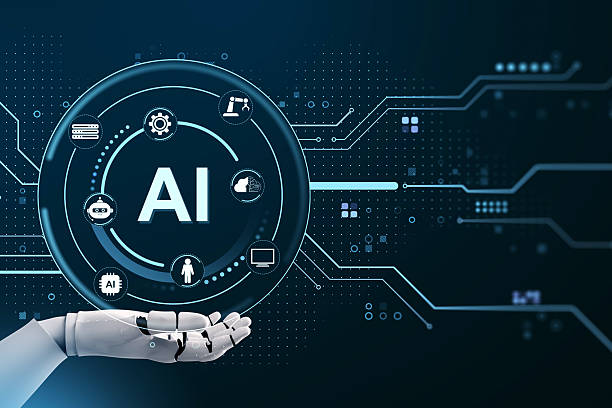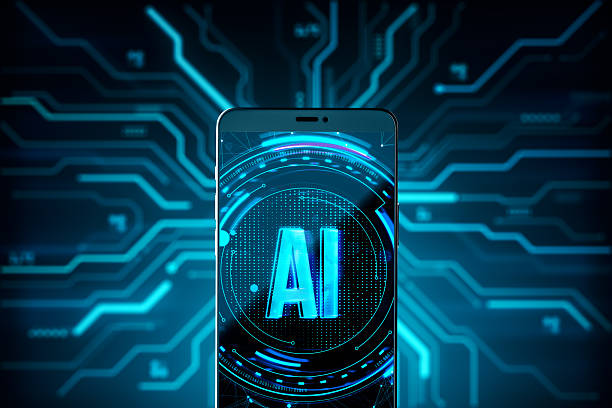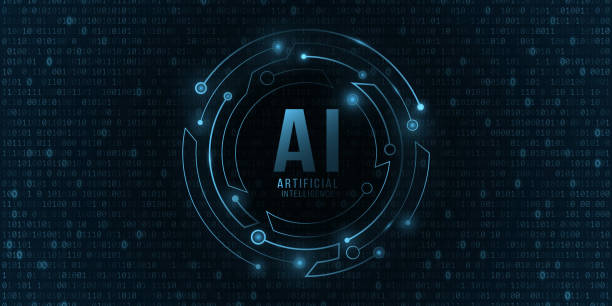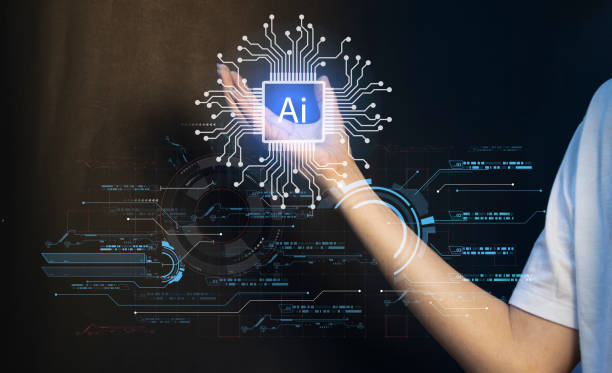What is Artificial Intelligence? A Comprehensive Definition

Artificial Intelligence (AI), or #Artificial_Intelligence, is, in short, a branch of computer science that deals with building machines capable of performing tasks that usually require human intelligence.
These tasks include learning, reasoning, problem-solving, understanding natural language, and pattern recognition.
Artificial intelligence is not just a technology, but a vast and multifaceted field that has applications in various fields such as medicine, engineering, economics, and art.
The main goal of #Artificial_Intelligence is to create systems that can make decisions and solve complex problems independently and without the need for direct human intervention.
In simpler terms, artificial intelligence is an attempt to simulate the power of human thought and reasoning in machines.
The term “artificial intelligence” was first coined in 1956 at a conference at Dartmouth College.
Since then, artificial intelligence has made remarkable progress and has become one of the most important research fields in computer science.
Artificial intelligence tries to give machines the ability to learn, reason, solve problems, and understand natural language.
In recent years, with advances in hardware and algorithms, artificial intelligence has become more widely used in our daily lives.
From voice assistants like Siri and Alexa to self-driving cars and movie and music recommendation systems, artificial intelligence is changing the way we interact with the world around us.
These changes not only make our lives easier, but also create new opportunities for innovation and progress in various fields.
In other words, artificial intelligence is becoming a major driving force in the modern world.
Are you worried that your company’s old website is scaring away new customers? Rasaweb solves this problem by designing a modern and efficient company website.
✅ Increases your brand credibility.
✅ Helps to attract targeted customers.
⚡ Contact Rasaweb for a free consultation!
Types of Artificial Intelligence: Approaches and Differences

Artificial intelligence can be categorized based on various criteria.
One of the most common methods is to categorize it based on the system’s capabilities.
Based on this, artificial intelligence is divided into two general categories:
- Weak AI (Narrow AI)
- Strong AI (General AI)
Weak artificial intelligence, also known as limited artificial intelligence, is designed to perform a specific task.
This type of artificial intelligence can perform very well in doing that task, but it cannot do other tasks.
Examples of weak artificial intelligence include facial recognition systems, language translation systems, and chess playing systems.
In fact, most of the artificial intelligence systems that are used today are of the weak artificial intelligence type.
These systems are very efficient in specific areas such as pattern recognition, predicting customer behavior, and optimizing processes.
Strong artificial intelligence, also known as general artificial intelligence, is a type of artificial intelligence that can do anything that a human can do.
This type of artificial intelligence is still in the development stages, and there is no real strong artificial intelligence system currently available.
The main goal of artificial intelligence researchers is to achieve strong artificial intelligence, because this type of artificial intelligence can create huge transformations in various fields.
For example, robots with strong artificial intelligence can help or even replace humans in dangerous and difficult tasks.
In addition, artificial intelligence can also be categorized based on the approach used in its development.
Some common approaches in artificial intelligence include machine learning, neural networks, and natural language processing.
Each of these approaches has its own advantages and disadvantages and is suitable for solving different problems.
Ultimately, choosing the right approach to artificial intelligence development depends on the type of problem and the available data.
Machine Learning: The Backbone of Artificial Intelligence

Machine Learning is one of the most important sub-branches of artificial intelligence that allows machines to learn from data without explicit programming.
In fact, machine learning allows machines to identify patterns and relationships in the data by analyzing the data, and to make decisions or make predictions based on these patterns.
Machine learning plays a fundamental role in many artificial intelligence applications, such as facial recognition, speech recognition, and prediction of customer behavior.
Machine learning is divided into three main categories:
- Supervised Learning
- Unsupervised Learning
- Reinforcement Learning
In supervised learning, the machine is trained using labeled data.
This means that for each input, the correct output is also provided to the machine.
By analyzing this data, the machine tries to create a learning model that can predict the correct output for new inputs.
In unsupervised learning, the machine is trained using unlabeled data.
In this case, the machine must automatically identify the patterns and relationships that exist in the data.
Reinforcement learning is also a type of machine learning in which the machine tries to create a learning policy that can maximize the reward by interacting with an environment.
Machine learning has become a powerful tool in various fields due to its ability to analyze large and complex data.
From stock market prediction to disease detection, machine learning is changing the way things are done in various industries.
In fact, machine learning is recognized as a major driving force in the Fourth Industrial Revolution.
| Learning Type | Description | Example |
|---|---|---|
| Supervised Learning | Training with labeled data | Facial Recognition |
| Unsupervised Learning | Training with unlabeled data | Customer Clustering |
| Reinforcement Learning | Learning through interaction with the environment | Computer Games |
Neural Networks Inspired by the Human Brain

Neural Networks are computational models that are inspired by the structure and function of the human brain.
A neural network consists of a large number of processing units called neurons, which are interconnected in a layered fashion.
Each neuron receives an input, processes it, and produces an output.
The output of each neuron is sent as input to the neurons in the next layer.
Neural networks are capable of performing complex tasks such as pattern recognition, data classification, and prediction by learning from data.
Neural networks have become one of the most popular methods in artificial intelligence in recent years due to advances in hardware and algorithms.
Deep Neural Networks, which have a large number of layers, have shown very good performance especially in areas such as computer vision, natural language processing, and speech recognition.
These networks are able to learn complex and abstract features from data, which makes them perform better than traditional machine learning methods in many applications.
Neural networks have wide applications in various fields.
From facial recognition in smartphones to disease detection in hospitals, neural networks are changing the way things are done in various industries.
In addition, neural networks are being used in self-driving cars, movie and music recommendation systems, and robotics.
With continued advances in the field of neural networks, it is expected that more applications of this technology will be seen in our daily lives in the future.
Did you know that 94% of users’ first impressions of a business are related to its website design? With professional corporate website design by **Rasaweb**, turn this initial impression into an opportunity for growth.
✅ Attract more customers and increase sales
✅ Create credibility and trust in the eyes of the audience⚡ Get a free website design consultation!
Natural Language Processing: Machine Communication with Human Language

Natural Language Processing (NLP) is a branch of artificial intelligence that allows machines to understand and generate human language.
The main goal of NLP is to create systems that can communicate with humans in natural language.
NLP includes a set of techniques and algorithms that are used to analyze, interpret, and generate human language.
NLP plays a fundamental role in many artificial intelligence applications, such as language translation, text summarization, and question answering.
NLP is divided into two main sub-branches:
- Natural Language Understanding
- Natural Language Generation
Natural language understanding allows machines to understand the meaning of text.
This includes identifying words, phrases, and sentences, as well as understanding the relationships between them.
Natural language generation allows machines to generate text in human language.
This includes choosing words, constructing sentences, and organizing text.
Artificial intelligence and especially NLP, allows machines to understand, interpret and generate human language.
NLP has wide applications in various fields.
From machine translation to sentiment analysis, NLP is changing the way we interact with technology.
NLP is also used in chatbot systems, voice assistants, and search systems.
With continued advances in the field of NLP, it is expected that more applications of this technology will be seen in our daily lives in the future.
For example, NLP can be used in detecting fake news, summarizing legal documents, and generating creative content.
Applications of Artificial Intelligence: From Medicine to Self-Driving Cars

Artificial intelligence (AI) is currently used in a wide range of industries and fields, and its applications are expanding day by day.
From medicine and healthcare to transportation and finance, artificial intelligence is changing the way things are done and improving efficiency and accuracy.
In this section, we will examine some of the most important applications of artificial intelligence in various industries.
In medicine, artificial intelligence is used in disease diagnosis, drug development, and treatment personalization.
Artificial intelligence systems can analyze medical images and detect signs of disease with higher accuracy than doctors.
In addition, artificial intelligence can help in the development of new drugs and personalize treatment based on each individual’s genetic characteristics.
For example, artificial intelligence systems can suggest drugs that are more likely to succeed by analyzing the genetic data of patients.
In transportation, artificial intelligence is used in the development of self-driving cars, route optimization, and traffic management.
Self-driving cars can understand their surroundings and drive without the need for human intervention by using sensors and artificial intelligence algorithms.
Artificial intelligence can also help in route optimization and traffic management.
Artificial intelligence systems can suggest the best routes to reach the destination by analyzing traffic data and prevent traffic congestion.
In finance, artificial intelligence is used in fraud detection, risk management, and providing personalized financial services.
Artificial intelligence systems can identify suspicious patterns by analyzing financial data and prevent fraud from occurring.
In addition, artificial intelligence can help in risk management and providing personalized financial services.
Artificial intelligence systems can suggest financial products and services that match their needs and goals by analyzing customers’ financial data.
However, artificial intelligence will not replace human analysis and can be used as a tool to assist in analysis.
Ethical Challenges of Artificial Intelligence and Accountability

With the rapid advancement of artificial intelligence, new ethical challenges also arise that require careful attention and review.
One of the most important of these challenges is the issue of accountability.
When an artificial intelligence system makes a wrong decision, who is responsible? Is it the developer, the user, or the artificial intelligence system itself? These questions require accurate and comprehensive answers.
Another ethical challenge of artificial intelligence is the issue of #bias.
Artificial intelligence systems are trained using data.
If this data is biased, the artificial intelligence system may also be biased.
For example, if a facial recognition system is trained using data that mostly includes images of white people, it may perform poorly in recognizing the faces of people of color.
To prevent this problem, diverse and balanced data should be used to train artificial intelligence systems.
Privacy is another ethical challenge of artificial intelligence.
Artificial intelligence systems need to collect and analyze a lot of data to do their job.
This data may include personal information of individuals.
To protect the privacy of individuals, strict laws and regulations must be put in place for the collection and use of data by artificial intelligence systems.
In other words, the use of artificial intelligence should be accompanied by respecting ethical principles and preserving the privacy of individuals.
| Challenge | Description | Solution |
|---|---|---|
| Accountability | Who is responsible for the wrong decisions of artificial intelligence? | Defining clear laws and regulations |
| Bias | Artificial intelligence may be biased due to biased data | Using diverse and balanced data |
| Privacy | Artificial intelligence needs to collect and analyze a lot of data | Enacting strict laws and regulations |
The Future of Artificial Intelligence: Outlook and Possibilities

The future of artificial intelligence is full of exciting possibilities and challenges.
With continued advances in hardware and algorithms, artificial intelligence is expected to play an even more important role in our daily lives in the coming years.
One of the most important trends in the future of artificial intelligence is the development of general artificial intelligence (AGI).
AGI is a type of artificial intelligence that can do anything that a human can do.
Achieving AGI can create huge transformations in various fields.
Another trend in the future of artificial intelligence is the integration of artificial intelligence with other technologies.
For example, the integration of artificial intelligence with the Internet of Things (IoT) can lead to the development of smarter systems that can understand their surroundings and automatically react to changes.
Integrating artificial intelligence with #robotics can also lead to the development of smarter robots that can help humans in dangerous and difficult tasks.
Artificial intelligence (AI) will continue to grow and develop in the near future and will have a profound impact on society and the economy.
For example, in the education sector, artificial intelligence can help improve the quality of education by providing personalized educational content and automatically evaluating student performance.
At the same time, the potential challenges arising from the development of artificial intelligence should also be considered and planned for their management.
For example, the issue of unemployment due to automation and the issue of protecting the privacy of individuals should be addressed.
In other words, the development of artificial intelligence should be accompanied by responsibility and attention to ethical aspects.
Are you lagging behind in competition with large online stores?
Rasaweb puts your business online with a professional online store design and increases your market share!
✅ Increased brand credibility and customer trust
✅ Easy shopping experience leads to more sales
⚡ Take action now to receive a free website design consultation!
Skills Needed to Enter the World of Artificial Intelligence

Entering the world of artificial intelligence requires acquiring a set of technical and soft skills.
One of the most important of these skills is programming knowledge.
Programming languages such as Python, R, and JavaScript are among the most used languages in artificial intelligence.
In addition to programming knowledge, mathematical knowledge is also essential for understanding the concepts and algorithms of artificial intelligence.
Concepts such as linear algebra, differential and integral calculus, and statistics are among the mathematical concepts that are used in artificial intelligence.
Knowledge of machine learning and neural networks is also essential for working in the field of artificial intelligence.
Machine learning allows machines to learn from data without explicit programming.
Neural networks are also computational models that are inspired by the structure and function of the human brain.
In addition, soft skills such as critical thinking, problem solving, and teamwork are also essential for success in the field of artificial intelligence.
To learn the skills needed to enter the world of artificial intelligence, various resources can be used.
Online courses, books, and articles are among the resources that can help you learn these skills.
In addition, participating in artificial intelligence projects and collaborating with experts in this field can also help you gain practical experience.
In other words, entering the world of artificial intelligence requires a lot of effort and perseverance.
The Impact of Artificial Intelligence on the Labor Market: Opportunities and Threats

Artificial intelligence (AI) will have a profound impact on the labor market.
On the one hand, artificial intelligence can lead to the creation of new job opportunities.
For example, with the development of artificial intelligence systems, the need for experts who can develop, maintain, and manage these systems will increase.
In addition, artificial intelligence can lead to increased productivity and reduced costs, which can lead to economic growth and the creation of new job opportunities in other industries.
On the other hand, artificial intelligence can lead to the loss of some jobs.
For example, with the automation of repetitive and routine tasks, the need for human labor in some industries will decrease.
To deal with this challenge, attention should be paid to the training and retraining of the workforce and to help people acquire new skills that are needed in the world of artificial intelligence.
Artificial intelligence (AI) can replace human labor in some cases.
In general, the impact of artificial intelligence on the labor market depends on how this technology is used.
If artificial intelligence is used correctly, it can lead to increased welfare and the creation of new opportunities.
But if the challenges arising from the development of artificial intelligence are not addressed, it may lead to increased inequality and unemployment.
In other words, the development of artificial intelligence should be accompanied by careful planning and attention to social and economic aspects.
Frequently Asked Questions
| Question | Answer |
|---|---|
| 1. What is Artificial Intelligence (AI)? | It is a branch of computer science that aims to create machines capable of simulating human intelligence and performing tasks that require human thinking, such as learning, problem solving, and decision making. |
| 2. What are the main types of Artificial Intelligence? | They can be classified into weak artificial intelligence (Narrow AI) that focuses on a specific task, general artificial intelligence (General AI) that possesses comprehensive human capabilities, and super artificial intelligence (Super AI) that exceeds human intelligence. |
| 3. Mention some common applications of Artificial Intelligence in our daily lives. | They include voice assistants (such as Siri and Alexa), recommendation systems (such as Netflix and Amazon), self-driving cars, facial recognition systems, and spam filters. |
| 4. What is the difference between Artificial Intelligence and Machine Learning? | Artificial intelligence is the broader concept of creating intelligent machines, while machine learning is a subset of artificial intelligence that focuses on enabling systems to learn from data without explicit programming. |
| 5. What is Deep Learning? | It is a subset of machine learning that uses multi-layered artificial neural networks (deep neural networks) to process data and discover complex patterns, and is used in image and speech recognition. |
| 6. What are the most prominent benefits of Artificial Intelligence? | Improving efficiency and productivity, automating repetitive tasks, making better decisions based on the analysis of big data, and developing solutions to complex problems in fields such as medicine and science. |
| 7. What are the main challenges facing the development and deployment of Artificial Intelligence? | They include the need for huge amounts of high-quality data, privacy and security issues, bias in data and algorithms, and high development and maintenance costs. |
| 8. Does Artificial Intelligence raise ethical or social concerns? | Yes, it raises concerns about privacy, algorithmic bias, job loss due to automation, and responsibility for errors committed by intelligent systems, and the need for a regulatory framework. |
| 9. How can Artificial Intelligence affect the future of the labor market? | It can lead to the automation of some routine tasks, but it will also create new jobs that require advanced skills in developing, operating, and maintaining artificial intelligence systems. |
| 10. What are some modern or promising technologies in the field of Artificial Intelligence? | They include advanced natural language processing (NLP) (such as large language models like ChatGPT), computer vision, robotics, and generative AI. |
And other services of Rasa Web advertising agency in the field of advertising
Intelligent conversion rate optimization: A novel service to increase online growth through a SEO-based content strategy.
Intelligent link building: Professional optimization for online growth using Google Ads management.
Intelligent digital advertising: An effective tool for analyzing customer behavior with the help of real data.
Intelligent advertising campaign: Designed for businesses looking to attract customers through intelligent data analysis.
Intelligent custom software: An effective tool for attracting customers with the help of a SEO-based content strategy.
And more than hundreds of other services in the field of internet advertising, advertising consulting and organizational solutions
Internet Advertising | Advertising Strategy | Reportage Ad
Resources
What is Deep Learning?
,What is Artificial Intelligence?
,What is Analytical Intelligence?
,Artificial Intelligence Applications
? To be seen and be a leader in the digital world, Rasaweb Digital Marketing Agency is with you. We take your business to the top by providing comprehensive services including personal website design, SEO, and social media management.
📍 Tehran, Mirdamad Street, next to Central Bank, South Kazerun Alley, Ramin Alley, No. 6


